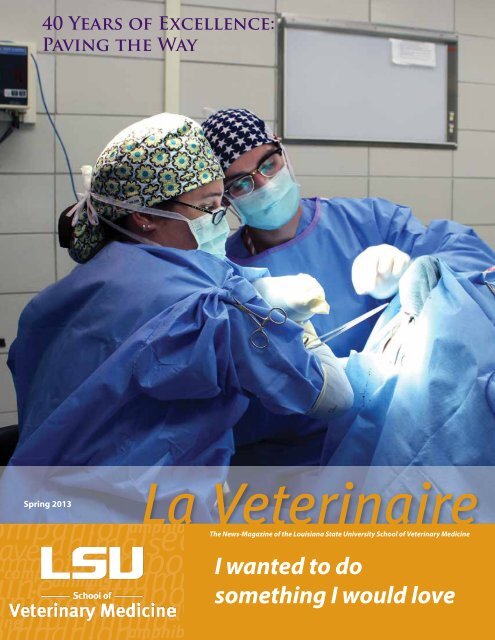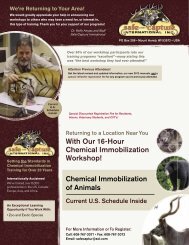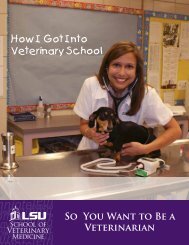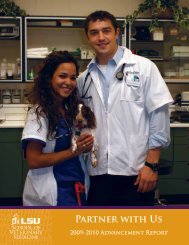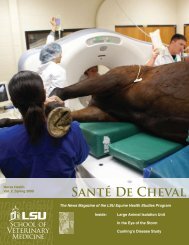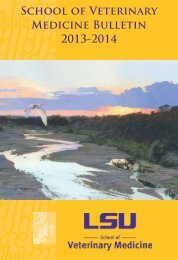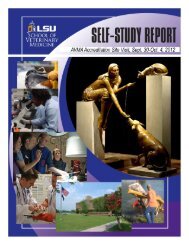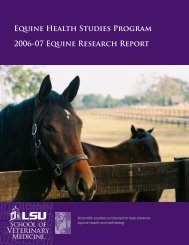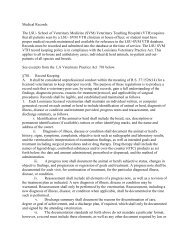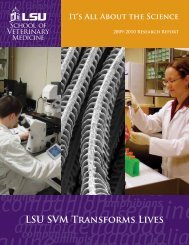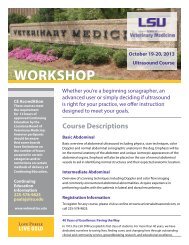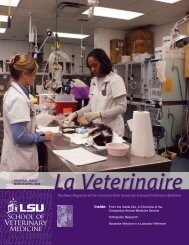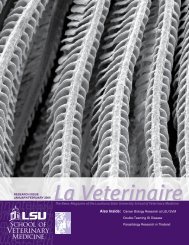Spring 2013 - School of Veterinary Medicine - Louisiana State ...
Spring 2013 - School of Veterinary Medicine - Louisiana State ...
Spring 2013 - School of Veterinary Medicine - Louisiana State ...
Create successful ePaper yourself
Turn your PDF publications into a flip-book with our unique Google optimized e-Paper software.
40 Years <strong>of</strong> Excellence:<br />
Paving the Way<br />
<strong>Spring</strong> <strong>2013</strong><br />
The News-Magazine <strong>of</strong> the <strong>Louisiana</strong> <strong>State</strong> University <strong>School</strong> <strong>of</strong> <strong>Veterinary</strong> <strong>Medicine</strong><br />
I wanted to do<br />
something I would love
LETTER FROM OUR DEAN<br />
Our students are the lifeblood <strong>of</strong> our school; they are the<br />
reason that we were founded. One aspect <strong>of</strong> the LSU SVM’s<br />
mission is to change lives through educational excellence.<br />
This issue <strong>of</strong> La Veterinaire highlights one <strong>of</strong> our students.<br />
Brandy Duhon (Class <strong>of</strong> <strong>2013</strong>) has overcome incredible<br />
odds to achieve her dream <strong>of</strong> becoming a veterinarian.<br />
She is just on one <strong>of</strong> more than 400 exceptional people<br />
(veterinary students, graduate students and hospital<br />
interns and residents) who have chosen the LSU SVM to<br />
further their educational and pr<strong>of</strong>essional goals.<br />
This issue also includes an update on the exceptional<br />
research conducted by our Equine Health Studies Program,<br />
as well as a clinical case study on a canine patient that was<br />
helped by multiple services in our hospital. We have been<br />
fortunate to add several stellar new faculty members, and<br />
you will meet them in this issue as well. It is our faculty, staff<br />
and students who make us great.<br />
In 1973, thirty-six <strong>Louisiana</strong> residents composed our<br />
inaugural class. In <strong>2013</strong>, we are celebrating the 40th<br />
anniversary <strong>of</strong> this achievement. Since then, the LSU<br />
SVM has bestowed 2,576 DVM degrees and 379 MS and<br />
PhD degrees. Our graduates work in the private sector, in<br />
academia, in the military and in government. We could not<br />
be more proud <strong>of</strong> their success.<br />
Our 40th anniversary celebrations will take place<br />
throughout the year as we showcase our people, our<br />
facilities and our programs. We hope that you can join us at<br />
our annual events, including the Great Rover Road Run and<br />
the Animals in Art exhibition, and at special events we will<br />
host this year as part <strong>of</strong> our 40th anniversary.<br />
Coinciding with our 40th anniversary is the kick-<strong>of</strong>f <strong>of</strong> our<br />
ABC Challenge, a fundraising plan to augment three key<br />
programs. Our goal is to take these aleady-exceptional<br />
areas <strong>of</strong> our school to even greater heights. Your generosity<br />
and support are vital to our continued success. This is an<br />
exciting time for the LSU SVM, and I hope that you will<br />
join us in celebrating our past, our present and our bright<br />
future.<br />
Sincerely,<br />
Peter F. Haynes, DVM, DACVS<br />
Dean<br />
LSU SCHOOL OF VETERINARY MEDICINE ADMINISTRATION<br />
Peter F. Haynes, DVM, MS, DACVS<br />
Dean<br />
James E. Miller, DVM, MPVM, PhD<br />
Interim Associate Dean for Research and Advanced Studies<br />
Joseph Taboada, DVM, DACVIM<br />
Associate Dean for Student and Academic Affairs<br />
David F. Senior, BVSc, DACVIM, DECVIM<br />
Associate Dean for Advancement and Strategic Initiatives<br />
Margaret C<strong>of</strong>fey, DVM, MBA<br />
Director, <strong>Veterinary</strong> Teaching Hospital<br />
Ernie Tanoos, MPA<br />
Assistant Dean for Finance and Administrative Services<br />
<strong>School</strong> <strong>of</strong> <strong>Veterinary</strong> <strong>Medicine</strong><br />
<strong>Louisiana</strong> <strong>State</strong> University<br />
Baton Rouge, <strong>Louisiana</strong> 70803<br />
Admissions (DVM Program) 225-578-9537<br />
Administration 225-578-9900<br />
Alumni Affairs 225-578-9565<br />
Continuing Education 225-578-9825<br />
Public Relations 225-578-9922<br />
Small Animal Clinic 225-578-9600<br />
Large Animal Clinic 225-578-9500<br />
www.vetmed.lsu.edu
ON THE COVER<br />
I Wanted to Do Something I Would Love<br />
Brandy Duhon lost her hands at the age <strong>of</strong> 13, but that hasn’t<br />
stopped her from fulfilling her dream <strong>of</strong> becoming a veterinarian.<br />
Brandy is a fourth-year veterinary student and will graduate in May<br />
<strong>2013</strong>. Read her story on page 4.<br />
BACK COVER IMAGE<br />
The 88 students in the Class <strong>of</strong> 2016 received their blue lab coats<br />
in August 2012, signifying the beginning <strong>of</strong> their formal veterinary<br />
medical education.<br />
LSU SVM PUBLICATIONS EARN AWARDS<br />
The Southern Public Relations Federation (SPRF) recognizes<br />
outstanding work in the field <strong>of</strong> public relations through<br />
its annual Lantern Awards program. Awards, including<br />
Certificates <strong>of</strong> Merit, Awards <strong>of</strong> Excellence and Lantern<br />
Awards, are given in 25 categories. The LSU SVM received<br />
Awards <strong>of</strong> Excellence for both La Veterinaire and the Annual<br />
Advancement Report in October 2012.<br />
Page 10<br />
Page 2<br />
Page 4<br />
TABLE OF CONTENTS<br />
Paving the Way: 40 Years <strong>of</strong> Excellence................................2<br />
I Wanted to Do Something I Would Love.............................4<br />
Equine Research........................................................................ 10<br />
Clinical Case: Peanut................................................................ 14<br />
New Faculty................................................................................. 16<br />
Life at the LSU SVM................................................................... 18<br />
DVM Alumnus Pr<strong>of</strong>ile............................................................... 20<br />
MS/PhD Alumnus Pr<strong>of</strong>ile........................................................ 21<br />
Alumni Tracks & Baby Vets..................................................... 22<br />
Advancement Team.................................................................. 24<br />
Upcoming Events...................................................................... 25<br />
http://www.facebook.com/LSUSVM<br />
http://twitter.com/LSUVetMed<br />
Betty Karlsson, CFRE<br />
Executive Director <strong>of</strong> Advancement<br />
Ginger Guttner, MMC, APR<br />
Director <strong>of</strong> Public Relations<br />
Mission:<br />
The LSU <strong>School</strong> <strong>of</strong> <strong>Veterinary</strong> <strong>Medicine</strong> is a dynamic community dedicated to saving lives,<br />
finding cures, and changing lives through outstanding clinical and community service,<br />
groundbreaking scholarly research and educational excellence.<br />
La Veterinaire is published by the <strong>Louisiana</strong> <strong>State</strong> University <strong>School</strong> <strong>of</strong> <strong>Veterinary</strong> <strong>Medicine</strong>,<br />
Office <strong>of</strong> Public Relations. Communications should be addressed to the Editor, La Veterinaire,<br />
<strong>School</strong> <strong>of</strong> <strong>Veterinary</strong> <strong>Medicine</strong>, <strong>Louisiana</strong> <strong>State</strong> University, Baton Rouge, LA 70803, or sent via<br />
e-mail to gguttner@lsu.edu.
In 1973, thirty-six <strong>Louisiana</strong> residents embarked<br />
on their veterinary careers at LSU. This inaugural<br />
class received their DVM degrees in 1977. More<br />
than 2,500 veterinary students later, the LSU<br />
SVM continues to provide future veterinarians with an<br />
exemplary education and the skills they need to provide<br />
the best possible care for animals, to investigate disease<br />
and injuries, and to provide our military and government<br />
with outstanding service.<br />
To commemorate the 40 years that we have been<br />
educating future veterinarians and MS and PhD<br />
students, the LSU SVM is hosting events throughout<br />
<strong>2013</strong> and is embarking on the ABC Challenge, a<br />
fundraising initiative focusing on enhancing key<br />
programs <strong>of</strong> the LSU SVM.<br />
Our annual events, such as Open House, the Great Rover<br />
Road Run and the International Exhibition on Animals<br />
in Art will all help celebrate our 40th anniversary. In<br />
addition, special events such as the Evening with Mike VI<br />
and our alumni homecoming weekend will highlight our<br />
past, present and future.<br />
On January 12, more than 100 people helped the<br />
LSU <strong>School</strong> <strong>of</strong> <strong>Veterinary</strong> <strong>Medicine</strong> kick <strong>of</strong>f its 40th<br />
anniversary celebrations! For more than 40 years, we<br />
have been dedicated to saving lives, finding cures,<br />
and changing lives through outstanding clinical and<br />
community service, groundbreaking research and<br />
educational excellence. The January 12 event also<br />
commemorated the 10th anniversary <strong>of</strong> the LSU SVM’s<br />
Cancer Treatment Unit, which opened in 2003.<br />
Attending the event were present and former clients and<br />
patients <strong>of</strong> the Cancer Treatment Unit and donors, as well as LSU SVM faculty and staff. Diane Deaton <strong>of</strong> WAFB’s 9 News This Morning and 9<br />
News at Noon served as mistress <strong>of</strong> ceremonies. Special guests included Dr. William Jenkins, interim president and chancellor (and former<br />
LSU SVM dean), and Dr. Mike Strain (LSU SVM 1983), commissioner for the <strong>Louisiana</strong> Department <strong>of</strong> Agriculture & Forestry.<br />
Guests were given tours <strong>of</strong> the <strong>Veterinary</strong> Teaching Hospital and got to hear stories from owners whose pets received medical care from the<br />
Cancer Treatment Unit.<br />
Coinciding with our 40th anniversary is our ABC Challenge, a fundraising plan to augment three key programs, such as advancing cures for<br />
cancer, biomedical and infectious disease research and Companion Animal Clinic enhancements. Each represents our future, our mission<br />
and our service to the community. The financial goal <strong>of</strong> this challenge is to raise $5 million for these three important missions <strong>of</strong> the LSU<br />
SVM. To learn more or to make a donation, please contact Laura Lanier, director <strong>of</strong> development, at llanier@lsu.edu or 225-578-9826 or Betty<br />
Karlsson, executive director <strong>of</strong> advancement, at bkarlsson@lsu.edu or 225-578-9870.<br />
2 40 YEARS OF EXCELLENCE: PAVING THE WAY
ABOVE: Ed Antie attended the<br />
40th Anniversary Launch Party<br />
with his dog, Annie.<br />
RIGHT: Also attending the Launch<br />
Party were Lisa Bates and her dog,<br />
Tipper.<br />
BELOW: Speaking at the LSU<br />
SVM’s 40th Anniversary Launch<br />
Party were (from left) Dr. Mike<br />
Strain (LSU SVM 1983), <strong>Louisiana</strong><br />
Department <strong>of</strong> Agriculture &<br />
Forestry commissioner; Diane<br />
Deaton with WAFB-TV; and Dr.<br />
Peter Haynes, dean.<br />
TOP: The cupcake-cake and cupcakes<br />
were generously donated for the<br />
event by April and Charles Ruffolo,<br />
owners <strong>of</strong> the <strong>Louisiana</strong> Culinary<br />
Institute.<br />
ABOVE: Attending the LSU SVM’s<br />
40th Anniversary Launch Party were<br />
(from left) Nadine Carter Russell, LSU<br />
Interim President and Chancellor<br />
William Jenkins and Margaret Womack<br />
Hart.<br />
40 YEARS OF EXCELLENCE: PAVING THE WAY 3
I Wanted to Do<br />
Something I Would Love<br />
Veterinarians are special; they combine a love and<br />
compassion for animals and a love for science into<br />
a career that helps both people and animals. It<br />
takes dedication, intelligence and caring to make a<br />
good veterinarian; most people would also assume that it requires<br />
hands, until they meet Brandy Duhon (Class <strong>of</strong> <strong>2013</strong>). The loss <strong>of</strong><br />
Brandy Duhon’s hands hasn’t stopped her from doing anything<br />
she’s set her mind to do.<br />
Brandy’s arms end a few inches below her elbows. In 1995,<br />
at the age <strong>of</strong> 13, Brandy thought she was suffering from the<br />
flu and had unexplained bruises on her arm and thigh. At the<br />
American Legion Hospital in Crowley, La., Brandy was diagnosed<br />
with meningococcal meningitis, which cut <strong>of</strong>f blood flow to<br />
her extremities. This led to gangrene in her hands and one foot;<br />
doctors amputated both hands and her right heel.<br />
Since then, Brandy has been told there are things she can never<br />
do, like walk without a brace or even walk barefoot. She’s never<br />
worn a brace, and she walks barefoot whenever she wants. She<br />
has completed her course work and will complete her clinical<br />
rotations in the LSU SVM’s <strong>Veterinary</strong> Teaching Hospital in May.<br />
The only accommodation made for her as a student was the<br />
addition <strong>of</strong> a new door handle for the third-year classroom (a<br />
larger one that’s easier to grab) ; Brandy can open a door with a<br />
door knob but has trouble doing it while holding an arm-load <strong>of</strong><br />
books.<br />
4 40 YEARS OF EXCELLENCE: PAVING THE WAY
Getting Into <strong>Veterinary</strong> <strong>School</strong><br />
Most veterinary students say that they always knew they wanted<br />
to be veterinarians. Brandy Duhon’s road to veterinary medicine<br />
was different. First, though she’s always been interested in<br />
science, she didn’t always want to be a veterinarian. When she<br />
was in college, she wanted to be an anesthesiologist; she later<br />
considered going into forensic science. By her junior year in<br />
college (she received her BS in science from the University <strong>of</strong><br />
<strong>Louisiana</strong>-Lafayette in 2005), Brandy began considering a career<br />
in veterinary medicine. “I knew that I wanted a job I could enjoy;<br />
something that didn’t feel like a job,” said Brandy. “I wanted to do<br />
something I would love.”<br />
Brandy was seriously considering a career in veterinary medicine<br />
when she met Dr. Renee Poirrier (LSU SVM 1988), who encouraged<br />
Brandy and invited her to come by her clinic to learn more<br />
about the pr<strong>of</strong>ession. Brandy ended up working at the Acadiana<br />
<strong>Veterinary</strong> Clinic for almost five years. “I started out at the<br />
bottom, just like everyone else,” said Brandy. “I worked kennels,<br />
then moved to reception, and then I worked as a technician.<br />
By the end, I was helping with surgeries.” It was Dr. Poirrier who<br />
encouraged Brandy to apply to the LSU SVM.<br />
Brandy was not accepted the first time she applied, or even the<br />
second. Dr. Rebecca McConnico (LSU SVM 1987), pr<strong>of</strong>essor <strong>of</strong><br />
veterinary medicine, met Brandy while she was applying to the<br />
LSU SVM. “When I first met Brandy, I was most impressed by<br />
her motivation; she was willing to do whatever it took to get<br />
into veterinary school,” said Dr. McConnico. “After reviewing her<br />
entire packet with her, we came up with a plan that we thought<br />
would put her in the best position for improving her ranking.<br />
She needed to convince the admissions committee that she was<br />
capable and committed to successful completion <strong>of</strong> advanced<br />
training. She was admitted to graduate school and began work<br />
OPPOSITE PAGE: Brandy Duhon assists Dr. James Wignall,<br />
companion animal surgery resident.<br />
TOP: Brandy receives her blue lab coat from Dr. Bruce Eilts,<br />
pr<strong>of</strong>essor <strong>of</strong> theriogenology, at the beginning <strong>of</strong> her first year <strong>of</strong><br />
veterinary school in August 2009.<br />
MIDDLE: Brandy (kneeling) participates in the Problem-Based<br />
Learning exercise with fellow second-year students.<br />
BOTTOM: Brandy receives her white coat from Dr. Renee Poirrier<br />
(LSU SVM 1988) during her third year <strong>of</strong> veterinary school in<br />
February 2012.<br />
40 YEARS OF EXCELLENCE: PAVING THE WAY 5
on a Master’s degree before applying to the LSU SVM again, when<br />
she was accepted.”<br />
than anyone else. Dr. Hilllmann never even asked if I thought I’d<br />
have trouble doing anything. He never questioned my ability.”<br />
Dr. McConnico added, “Brandy’s life experiences are dramatically<br />
different than most people’s, but she has not allowed her physical<br />
challenges to keep her from pursuing her dreams and finding<br />
her place in our pr<strong>of</strong>ession. We are always looking for great<br />
role models in our students—people who will contribute to a<br />
pr<strong>of</strong>ession rich in diversity and contribute to society. I knew she<br />
would make a positive difference; she has more than done that<br />
as a student, and I can’t wait to see what she is going to do as a<br />
veterinarian.”<br />
Classes and Labs<br />
Clinical Rotations<br />
Brandy’s favorite part <strong>of</strong> third-year (before clinics) was the surgery<br />
lab. “My first spay was incredible,” said Brandy. Spays are done<br />
in teams <strong>of</strong> three: one student performs the surgery (under<br />
supervision), one student assists, and the third student performs<br />
anesthesia. “For surgery, I keep the gloves inside-out so the fingers<br />
stay in the gloves,” said Brandy. “I also use an instrument called a<br />
Mathieu needle holder to suture. It uses opposing force to clamp.”<br />
The Mathieu does not have finger holes; it has handles that spring<br />
open when the ratchet is activated.<br />
Brandy arrived at the LSU SVM for her first year <strong>of</strong> veterinary<br />
school in August 2009. She didn’t know any <strong>of</strong> her classmates<br />
before then but soon found out that her physician’s son, Logan<br />
Curtis, was in her class. “He came up to me and introduced<br />
himself,” said Brandy, “but I never knew he existed before that. It<br />
was strange because I’m so close to his dad<br />
(who basically saved my life), but I hadn’t met<br />
Logan before we started vet school.”<br />
Along with the rest <strong>of</strong> her class, Brandy<br />
participated in the Freshman Leadership<br />
Experience, a one-day session prior to the<br />
class’s formal orientation; FLE gives the<br />
students a chance to get to know one another<br />
before the rigors <strong>of</strong> school begin. The class is<br />
divided into groups that must work together on different teambuilding<br />
projects, such as building a boat out <strong>of</strong> cardboard and<br />
duct tape before rowing the boat across a pool.<br />
After FLE and orientation, the first-year students start classes and<br />
anatomy lab; students work in pairs to learn anatomy. “I remember<br />
Christine Zewe approached me and said, ‘What do you think<br />
about us being partners’” said Brandy. “We just went from there<br />
and were partners for lab that whole year.”<br />
There were some adjustments Brandy had to make to participate<br />
in lab. “I purchased larger forceps, and I taped the scalpel holder<br />
to my arm.”<br />
“In anatomy lab, Dr. [Daniel] Hilllmann and Dr. [Hermann] Bragulla<br />
were amazing,” added Brandy. “They didn’t treat me any different<br />
She has taught me that<br />
if someone is determined<br />
enough—if something<br />
means enough to<br />
someone—they will find<br />
a way to do it no matter<br />
the odds against them.<br />
One <strong>of</strong> the classmates assisting Brandy performed with that<br />
first spay was Erika Fauth. “On the day <strong>of</strong> surgery, Brandy was<br />
extremely composed but excited for her first live surgery,” said<br />
Erika. “She had everything organized and ready to go. Our dog<br />
happened to be in heat so the surgery was tough, but Brandy<br />
remained level-headed. I was extremely<br />
impressed with how she handled the<br />
situation, and our dog did great afterwards! I<br />
actually fostered the dog after her surgery and<br />
found her a great home and she continues to<br />
do well.”<br />
In the second semester <strong>of</strong> the third year,<br />
veterinary students begin their hospital<br />
rotations. Brandy’s first block was equine<br />
medicine with Dr. Susan Eades (LSU SVM 1982). “I loved equine<br />
medicine so much I cried when I was done,” said Brandy. “My last<br />
patient was a horse that ripped out her catheter one night. I had<br />
just gotten the catheter in her neck and was leaving,when she<br />
took her rear, right leg and ripped it out. I ran back to her, and the<br />
technician and I got it back in.”<br />
Dr. McConnico said, “I have worked with Brandy in equine<br />
clinical skills labs but did not work with her when she was on<br />
her equine rotation; however, I do know that she impressed the<br />
heck out <strong>of</strong> my colleagues with both her physical and intellectual<br />
contributions. She is super smart and a leader in the class. I think<br />
she was able to complete all <strong>of</strong> the clinical skills that are expected<br />
<strong>of</strong> all <strong>of</strong> our students (except maybe a rectal exam on a horse -<br />
although, knowing Brandy—she somehow probably managed to<br />
do that too!)”<br />
6 40 YEARS OF EXCELLENCE: PAVING THE WAY
Said Dr. Susan Eades (LSU SVM 1982), pr<strong>of</strong>essor <strong>of</strong> veterinary<br />
medicine, “Brandy was actively engaged in all aspects <strong>of</strong> patient<br />
management—patient care, diagnostic and therapeutic<br />
management—during her equine rotation. She rapidly improved<br />
her skills in diagnostic and therapeutic planning during the rotation.<br />
Brandy worked tirelessly on her own cases and helped other<br />
students with their cases. She was a leader in organizing the efforts<br />
<strong>of</strong> all members <strong>of</strong> the rotation to accomplish the necessary tasks.<br />
Her overwhelmingly positive attitude in situations <strong>of</strong> adversity was<br />
contagious to all members <strong>of</strong> the rotation. I sometimes found myself<br />
wanting to help her take care <strong>of</strong> her patients but quickly realized<br />
that I didn’t need to. There is very little that she cannot do. I am<br />
looking forward to great things being done by her upon graduation.”<br />
“I also loved shelter medicine with Dr. [Wendy] Wolfson,” said Brandy.<br />
“Dixon Correctional Institute was my favorite shelter we visited. The<br />
inmates are so dedicated and genuinely honored to be working<br />
with the animals there. They’re so eager to learn and very concerned<br />
for the animals.”<br />
Dr. Wolfson (LSU SVM 1986), instructor <strong>of</strong> veterinary surgery, said, “I<br />
will miss her after graduation. I know her employers and clients are<br />
getting a great veterinarian. She made my job fun; her commitment<br />
to her studies and her great sense <strong>of</strong> humor make her a joy to<br />
teach. Brandy never says she can’t do something; she does what<br />
she sets out to do but perhaps in a different way.’ That girl has never<br />
used the phrase, ‘I give up.’ She is a true inspiration to me. At Dixon<br />
Correctional, the inmates asked her so many questions about her<br />
disability (not a word I think <strong>of</strong> when I think <strong>of</strong> Brandy), and she was<br />
so patient and honest in answering them. They were very impressed.<br />
She makes me believe in the human spirit—that we can achieve<br />
many things in life beyond what others think we can.”<br />
Working with clients and patients is Brandy’s favorite part <strong>of</strong><br />
veterinary school. “When I first started clinics, I spoke with Stephanie<br />
Johnson [licensed social worker and school counselor] about how<br />
I should approach clients,” said Brandy. “We agreed that I’m used<br />
to people’s different reactions to me, and I can tell when someone<br />
TOP: Brandy received the <strong>Louisiana</strong> <strong>Veterinary</strong> Medical<br />
Association Outstanding Student Award in 2012 along with Anna<br />
Ozio (Class <strong>of</strong> 2012) and Elise Madara (Class <strong>of</strong> 2014). Dr. Gary<br />
Levy (LSU SVM 1982) presented the award (left). Congratulating<br />
the recipients is Dr. Peter F. Haynes, dean (right).<br />
MIDDLE: Brandy enjoys the Spanish Town Mardi Gras Parade in<br />
February <strong>2013</strong>. To her right is her boyfriend, Joe Del Diaz.<br />
BOTTOM: Brandy with classmates Stacy Landers (center) and<br />
Erika Fauth at the <strong>2013</strong> Spanish Town Mardi Gras Parade.<br />
40 YEARS OF EXCELLENCE: PAVING THE WAY 7
is waiting for me to talk about it. I haven’t had a problem with any<br />
client. No one has indicated that they think I can’t do my job. Over<br />
the Christmas holiday, we had a family come in with their dog while<br />
I was on my emergency rotation. They were distraught because<br />
there was nothing we could do for the dog. The mother asked me to<br />
stay with the family while their dog was euthanized and that really<br />
touched me. That connection you make with the pet owner is very<br />
important to me. You provide care for their pet, but you know that<br />
you’ve touched a place in that person’s heart as well.”<br />
While on her companion animal surgery rotation, Brandy assisted<br />
Dr. James Wignall, surgery resident. The dog’s veterinarian palpated<br />
a mass in the dogs left anal gland, and it was diagnosed as Apocrine<br />
gland adenocarcinoma <strong>of</strong> the anal sac. “We removed the entire left<br />
anal sac,” said Brandy. “I assisted Dr. Wignall by holding and passing<br />
instruments and suturing the skin.”<br />
In August 2012, Brandy did an externship at Quitman Animal<br />
Clinic, a mixed animal practice in Quitman, Texas, and had a<br />
great experience. She will go back to that clinic in <strong>2013</strong> for a<br />
preceptorship. Brandy worked with Dr. Randall Bennett (LSU SVM<br />
1984). “They had no hesitation about me whatsoever,” said Brandy.<br />
“They said they didn’t want to hold me back. It was my ideal clinic.<br />
The clinicians take time to help the technicians, and everyone<br />
stepped up to help everyone else. One doctor might prefer to work<br />
with farm animals, but if a client comes in with a dog and that<br />
doctor is available, he sees the dog.”<br />
When Brandy gets back from Quitman, she’ll have her last few<br />
rotations before graduation: nephrology, theriogenology and a<br />
preceptorship at Dr. Poirrier’s clinic in Lafayette. After graduation,<br />
Brandy would like to work in a mixed animal practice (caring for<br />
pets, horses and farm animals).<br />
Relationships<br />
Brandy has been in a relationship for more than 12 years. Her<br />
boyfriend, Joe Del Diaz, is a purchasing manager for an oil company<br />
(a job that allows him to work from anywhere), and he’s prepared to<br />
relocate depending on where Brandy finds a job after graduation.<br />
Brandy and Joe met in a bar. “I really wish it was a better story,” says<br />
Brandy. “The first thing he ever said to me was, ‘Would you ever get<br />
married’ I said, ‘Hell no,’ and he said, ‘Hello. My name is Joe Del Diaz.’<br />
He was there with a buddy who was getting a divorce, but we do<br />
plan to get married some day. He’s awesome.”<br />
8 40 YEARS OF EXCELLENCE: PAVING THE WAY
Brandy has made many friends at the LSU SVM. Peter Armstrong<br />
(Class <strong>of</strong> <strong>2013</strong>) did a four-week externship at Quitman Animal<br />
Clinic at the same time as Brandy. “Brandy is one <strong>of</strong> my best<br />
friends,” said Peter. “She is by far one <strong>of</strong> the most outstanding<br />
people I have ever met in my life. She has more determination<br />
than anyone I know and allows no one or nothing to set her back.<br />
She can draw blood, give injections, and restrain the biggest dog<br />
in the room, all while having the best attitude. I have never seen<br />
one thing she could not do. One <strong>of</strong> our biggest laughs is that<br />
when she palpates, she needs to wear earplugs. She has taught<br />
me that if someone is determined enough—if something means<br />
enough to someone—they will find a way to do it no matter the<br />
odds against them.”<br />
Added Erika Fauth (Class <strong>of</strong> <strong>2013</strong>), “Brandy is the most strongwilled<br />
yet s<strong>of</strong>t-hearted person I have every met. She will never<br />
give up on herself or give in to her handicap. She is a great friend<br />
and has taught me so much about myself.”<br />
Brandy has been on the Dean’s Honor List <strong>of</strong> Scholastic<br />
Achievement for 2010, 2011 and 2012 by maintaining a grade<br />
point average <strong>of</strong> 3.5 or higher during her pr<strong>of</strong>essional training.<br />
In 2012, she received the Outstanding Student Award from the<br />
<strong>Louisiana</strong> <strong>Veterinary</strong> Medical Association, which is presented to<br />
one student from Years II, III, and IV, selected by the faculty on the<br />
basis <strong>of</strong> scholastic achievement, demonstrated leadership ability,<br />
and pr<strong>of</strong>essional attitude and acumen.<br />
Dr. Kirk Ryan, assistant pr<strong>of</strong>essor <strong>of</strong> veterinary medicine, said<br />
“Brandy is a bit <strong>of</strong> a paradox. On one level, she is the most<br />
inspiring person I have met. On another, she is just part <strong>of</strong> the<br />
team—an extraordinary veterinary student—no different than<br />
any other great team player we have on board. When I first<br />
observed her, I was fascinated by the things she could do. From<br />
working together, I know that she can essentially do anything that<br />
I can do. It’s amazing to think about it, but now I never give it a<br />
second thought. If you asked me to describe Brandy, it wouldn’t<br />
occur to me talk about a physical limitation; I would describe<br />
her as brilliant, clever, funny, insightful, humble, hard working,<br />
compassionate and caring. Oh, and she also has brown hair....and<br />
she’s a bit <strong>of</strong> a smart aleck.”<br />
PHOTOS FROM TOP: Brandy with Dr. Anderson da Cunha,<br />
associate pr<strong>of</strong>essor <strong>of</strong> veterinary anesthesiology.<br />
Facts and Figures for the<br />
Class <strong>of</strong> 2016<br />
Tuition Costs (based on 2012-<strong>2013</strong>)<br />
<strong>Louisiana</strong> resident: $8,915 per semester<br />
Non-resident:<br />
Class <strong>of</strong> 2016 Statistics<br />
$21,415 per semester<br />
Total applicants 798<br />
Total admitted 88<br />
Breakdown by applicant type<br />
<strong>Louisiana</strong> residents 63<br />
Arkansas residents 9<br />
Out-<strong>of</strong>-<strong>State</strong> residents 16<br />
Demographics<br />
Average GPA<br />
Female 69 (78.4%)<br />
Male 19 (21.6%)<br />
Average age 23.7 (range 20 to 45)<br />
Required course GPA 3.77<br />
Last 45 hours GPA 3.75<br />
For previous class statistics and admission<br />
requirements, please go to http://www.<br />
vetmed.lsu.edu and then “Admissions”<br />
under “Academics.”<br />
Brandy discusses her cases during surgical rounds.<br />
Brandy assists Dr. James Wignall, companion animal surgery<br />
resident, with one <strong>of</strong> her surgery cases.<br />
40 YEARS OF EXCELLENCE: PAVING THE WAY 9
Research<br />
Dr. Frank Andrews, director <strong>of</strong> the Equine Health Studies Program, investigates gastrointestinal diseases.<br />
Research Program Focuses on<br />
Equine Diseases and Injuries<br />
The LSU SVM is home to the Equine Health Studies Program (EHSP),<br />
a premier clinical specialty and biomedical training and research<br />
program dedicated to improving the lives <strong>of</strong> horses. Central to the<br />
program’s core research efforts is the Charles V. Cusimano Equine<br />
Physiology and Pharmacology Laboratory, where collaborative<br />
studies are conducted in the areas <strong>of</strong> vascular and nonvascular<br />
physiology and pharmacology relating to laminitis and airway<br />
diseases, gastrointestinal diseases, reproduction, and pain<br />
management.<br />
Gastrointestinal Diseases<br />
Gastric Ulcers<br />
In 2012, Dr. Frank Andrews, EHSP director, and his research team<br />
focused on the use <strong>of</strong> feed supplements containing natural<br />
ingredients to treat and prevent stomach ulcers, a common horse<br />
ailment. The team found that adding a zinc supplement to the<br />
diet with omeprazole (an acid-blocking pharmacologic agent)<br />
might help prevent stomach ulcers. The information is especially<br />
important for horses housed in stalls, fed twice daily and in a hot,<br />
humid climate.<br />
Sea buckthorn berries (Hippophae rhamnoides), are rich in vitamins<br />
C and E, carotenoids, flavonoids, fatty acids, plant sterols, lignins,<br />
and minerals. A study performed by Dr. Andrews’s team found<br />
that a feed supplement containing sea buckthorn berries and pulp<br />
(SeaBuck SBT Gastro-Plus liquid) showed effectiveness in treatment<br />
<strong>of</strong> naturally occurring stomach ulcers in the lower part (glandular<br />
region) <strong>of</strong> the horse stomach. In addition, another study found that<br />
a supplement (SmartGut® Ultra) containing sea buckthorn berries<br />
and natural antacids prevented gastric ulcers from getting worse<br />
after omeprazole treatment and might be an affordable alternative<br />
to help guard against stomach ulcers, especially after omeprazole<br />
treatment is discontinued.<br />
10 40 YEARS OF EXCELLENCE: PAVING THE WAY
Colic<br />
Colic is the leading cause <strong>of</strong> morbidity and mortality in horses.<br />
Diseases <strong>of</strong> the large intestine are a major cause <strong>of</strong> colic, causing<br />
varying degrees <strong>of</strong> debilitation and death in horses. EHSP<br />
researchers, including Dr. Rebecca McConnico (LSU SVM 1987),<br />
continue to work to determine the reasons behind large intestinal<br />
diseases and to look at associations between gastrointestinal<br />
disease and laminitis. Their goal is to find effective treatments that<br />
prevent or reduce damage from these life-threatening conditions.<br />
Dr. McConnico’s research team is focused on cyclooxygenase<br />
inhibitors, such as Phenylbutazone (bute), that are <strong>of</strong>ten used<br />
to treat arthritis and muscle pain in equine athletes worldwide.<br />
Although initially thought to be well-tolerated in horses, research<br />
shows that the drugs can cause adverse side-effects including<br />
stomach and colon inflammation and ulceration and kidney<br />
dysfunction even when given at recommended doses. Dr.<br />
McConnico’s team showed that prolonged bute administration<br />
caused hypoalbuminemia, neutropenia, changes in colonic blood<br />
flow, and changes in volatile fatty acids. Based on this information,<br />
veterinarians should use these drugs with caution when treating<br />
horses.<br />
Another pharmacologic study by Dr. McConnico’s team evaluated<br />
the safety <strong>of</strong> an oral paste formulation <strong>of</strong> a commercially available<br />
COX1-sparing NSAID, firocoxib (Equioxx®, Merial Limited, Duluth,<br />
Ga.) in clinically healthy 6-week-old pony foals. Results revealed that<br />
firocoxib administration did not have adverse effects on stomach,<br />
intestines or blood values and was well tolerated.<br />
The Charles V. Cusimano Equine Physiology and Pharmacology<br />
Laboratory is home to summer scholars and graduate student<br />
projects since its dedication in 2011. Their studies have covered<br />
such topics as evaluating mechanisms <strong>of</strong> inflammation and<br />
secretion in the large colon with and without metronidazole,<br />
lidocaine or meloxicam. Equine colonic tissue samples are evaluated<br />
outside <strong>of</strong> the body using Ussing chambers to recreate the normal<br />
environment in the body to study tissue secretion, permeability<br />
and healing. Dr. McConnico and her colleagues continue to provide<br />
close one-on-one mentoring to eager young scientists to tackle<br />
some <strong>of</strong> these major equine medical problems.<br />
Musculoskeletal Diseases<br />
Stem Cells as Treatment<br />
Stem cells have evolved as a common treatment approach in<br />
veterinary medicine. “To develop stem cell therapies, we need to<br />
first optimize and describe their behavior in the laboratory to help<br />
us predict how they will behave in the body,” says Dr. Mandi Lopez,<br />
director <strong>of</strong> the Laboratory for Equine and Comparative Orthopedic<br />
Research. Dr. Lopez and colleagues isolated multipotent stromal<br />
cells (immature stem cells in adult tissues) from equine bone<br />
marrow and fat. These stem cells participate in tissue maintenance<br />
and healing by maturing into adult cells as needed. Dr. Lopez’s team<br />
has successfully isolated and grown stem cell in the lab and focuses<br />
on uses <strong>of</strong> these cells in equine disease. Dr. Lopez and colleagues<br />
looked at the ability <strong>of</strong> multipotent stromal cells from bone and<br />
adipose tissue to produce bone, adipose and cartilage neotissue<br />
on pieces <strong>of</strong> collagen called a scaffold, which provides a framework<br />
for the cells to attach and produce tissue. The key finding <strong>of</strong> this<br />
study was that adult equine stem cells, when loaded onto collagen<br />
scaffolds, turned into fat, bone and cartilage. This is promising and<br />
may mean that stem cells may be used for tissue regeneration.<br />
“These findings support our ongoing efforts to develop equine stem<br />
cell tissue regeneration to provide new and improve upon existing<br />
treatment options”, says Dr. Lopez.<br />
Laminitis<br />
For the past 15 years, notable progress in understanding equine<br />
laminitis through research has been achieved under the direction<br />
<strong>of</strong> Dr. Susan Eades (LSU SVM 1982). As one <strong>of</strong> the two recipients <strong>of</strong><br />
Grayson Jockey Club Research Foundation “Barbaro” Grant, Dr. Eades<br />
continues to evaluate treatment and prevention strategies for this<br />
devastating disease in horses. Laminitis can result in separation <strong>of</strong><br />
the ho<strong>of</strong> layers, known as lamina, <strong>of</strong>ten resulting in rotation <strong>of</strong> the<br />
c<strong>of</strong>fin bone (distal phalanx), an irreversible and deadly condition.<br />
Anecdotal observations and results <strong>of</strong> survey studies indicate that<br />
most laminitis cases occur in horses and ponies kept at pasture.<br />
Risk for development <strong>of</strong> pasture-associated laminitis results from<br />
high nonstructural carbohydrate content <strong>of</strong> the pasture grass and<br />
from animal-predisposing factors. Horses that have circulating<br />
concentrations <strong>of</strong> insulin (insulin resistance) are more likely<br />
to develop laminitis when grazing pasture grasses. Dr. Eades’s<br />
research team studies laminitis by infusion <strong>of</strong> insulin and glucose<br />
intravenously.<br />
Another goal <strong>of</strong> Dr. Eades’s team is to measure biomarkers in the<br />
blood during insulin induced laminitis. A biomarker is a protein that<br />
is produced by the body in response to disease. Risk assessment<br />
by use <strong>of</strong> biomarkers is becoming increasingly common practice<br />
in both human and veterinary medicine; however, the use <strong>of</strong><br />
biomarkers in equine laminitis has not yet been established. Dr.<br />
Eades’s research team is evaluating the useful <strong>of</strong> biomarkers in<br />
assessing the risk <strong>of</strong> laminitis occurrence on pasture.<br />
40 YEARS OF EXCELLENCE: PAVING THE WAY 11
During laminitis, enzymes (metalloproteinases) that degrade the<br />
structures holding the ho<strong>of</strong> wall to the pedal bone are produced.<br />
Dr. Eades’s team has shown that pentoxifylline is a potent inhibitor<br />
<strong>of</strong> these enzymes in the horse and that it effectively reduces<br />
lameness during laminitis. Another goal is to evaluate the effects <strong>of</strong><br />
pentoxifylline on laminitis caused by insulin.<br />
Laminitis and Stem Cells<br />
Complex ho<strong>of</strong> structure and the complicated nature <strong>of</strong> laminitis<br />
make study and treatment <strong>of</strong> laminitis a challenging endeavor.<br />
Studies have shown that lamina tissue is irreversibly altered by<br />
laminitis, regardless <strong>of</strong> the cause <strong>of</strong> the inflammation. The presence<br />
<strong>of</strong> stem cells in the ho<strong>of</strong> is necessary for normal growth and<br />
healing. Based, on this knowledge, Dr. Lopez and her colleagues<br />
theorized that the permanent changes in ho<strong>of</strong> wall structure from<br />
laminitis might be due to loss or damage to the ho<strong>of</strong> stem cells. In<br />
order to investigate this theory, methods have been developed to<br />
isolate and grow stem cells from normal and laminitic hooves. Early<br />
results have confirmed that the isolated cells are capable <strong>of</strong> turning<br />
into several cell types, a characteristic <strong>of</strong> stem cells. This exciting<br />
discovery provides a new way to study and compare stem cells<br />
from normal hooves and those with naturally occurring laminitis.<br />
The possibilities to study causes, treatments and prevention <strong>of</strong><br />
laminitis using this new, laboratory model hold significant promise<br />
to improve the health and well-being <strong>of</strong> horses.<br />
Infectious Diseases<br />
Rhinitis Virus<br />
Raising funds for<br />
biomedical research.<br />
Respiratory disease is common in race horses. The economic impact<br />
<strong>of</strong> viral induced infectious respiratory disease, such as Equine<br />
Influenza virus (EIV) and Equine Herpes virus (EHV), on the horse<br />
industry is substantial. Despite this, little is known about Equine<br />
Rhinitis Virus (serotypes ERV-1 and ERV-2) in racehorses housed<br />
and trained at <strong>Louisiana</strong>. Dr. Andrews’s research team conducted a<br />
study to determine seroprevalence <strong>of</strong> ERV in horses at a racetrack,<br />
training center, and a university farm in southern <strong>Louisiana</strong>. The<br />
study revealed that ERV-1 and ERV-2 were present, and ERV-1 was<br />
more prevalent in horses housed at the race track and university<br />
farm, compared to the training facility. The difference in prevalence<br />
at these facilities may be due to age, as horses at the racetrack and<br />
university farm were older allowing more time for virus exposure.<br />
ERV appears to be prevalent in horses in <strong>Louisiana</strong> and warrants<br />
further epidemiologic investigation to determine its impact on<br />
racing and training and the need for vaccine development to reduce<br />
impact.<br />
Equine Herpes Virus<br />
Through joint efforts with private practitioners, the state<br />
veterinarian’s <strong>of</strong>fice, and the <strong>Louisiana</strong> Disease Diagnostic<br />
Laboratory (LADDL), EHSP researchers (Drs. Frank Andrews, Susan<br />
Eades, Rebecca McConnico and Alma Roy) continue to report<br />
on the management <strong>of</strong> Equine Herpesvirus Type 1 infections in<br />
<strong>Louisiana</strong> and the region. The team, along with colleagues from<br />
other universities, has reported on outbreak scenarios and the<br />
importance <strong>of</strong> minimizing economic losses, while protecting the<br />
health and welfare <strong>of</strong> horses by encouraging equine veterinarians<br />
and regulatory <strong>of</strong>ficials to agree on nomenclature, case definition,<br />
interpretation <strong>of</strong> molecular diagnostic tests, and appropriate<br />
biosecurity responses.<br />
Respiratory Disease (RAO)<br />
Recurrent airway obstruction (RAO) is a debilitating respiratory<br />
disorder in horses, similar to human asthma. Dr. Changaram<br />
Venugopal is focused on airway hyperreactivity and is characterizing<br />
and identifying inflammatory mediators <strong>of</strong> diseases. Dr. Venugopal’s<br />
team is focused on inflammatory mediators in Summer Pasture<br />
Associated Obstructive Pulmonary Disease (SPAOPD), which<br />
is common in <strong>Louisiana</strong>. These mediators are responsible for<br />
contraction <strong>of</strong> airway smooth muscles, increased vascular<br />
permeability leading to edema, increased mucus secretion and<br />
damage to airway epithelium.<br />
In recent years, Dr. Venugopal and his colleagues have examined<br />
alterations in tissue receptors <strong>of</strong> two important mediators,<br />
endothelin and neurokinin-A, during their transformation from<br />
healthy state to a disease state. The findings <strong>of</strong> the investigation<br />
<strong>of</strong> novel antagonists <strong>of</strong> these receptors, particularly endothelin B<br />
receptor antagonists for endothelin and NK-2 receptor antagonists<br />
for neurokinin, suggested a potential use <strong>of</strong> them in RAO in horses.<br />
Currently, Dr. Venugopal and his team are working to find a vaccine<br />
for RAO. Their emphasis is on the unique role <strong>of</strong> an endogenous<br />
anti-inflammatory proteins (Secretoglobulin family) produced by<br />
Clara Cells in the airways. These proteins are believed to be block<br />
inflammation which is the primary cause airway injury and leave<br />
the airways vulnerable to attack by allergens. Dr. Venugopal and<br />
his collaborator, Dr. Sudhiridas K. Prayaga, an immunologist, were<br />
able to identify and develop a peptide (Patent pending) that could<br />
produce antibodies to protect animals from seasonal allergy. Dr.<br />
12 40 YEARS OF EXCELLENCE: PAVING THE WAY
Venugopal’s team is planning to investigate whether a subcutaneous administered<br />
peptide will prevent RAO in horses.<br />
Theriogenology (Reproduction)<br />
Theriogenology research in the EHSP includes stallion and mare reproduction. Dr.<br />
Sara Lyle and her research team have investigated the response <strong>of</strong> the immune<br />
system and the fetal endocrine system in response to bacteria that lead to abortion<br />
in the mare. Most notable was the discovery that inflammation post-infection<br />
precociously matures the fetal hypothalamic-pituitary-adrenal axis (responsible for<br />
the production <strong>of</strong> cortisol—a key hormone in response to stress). These findings<br />
explain in part why foals that survive following delivery subsequent to placentitis<br />
are more mature than foals that are delivered prematurely due to other reasons.<br />
Another group <strong>of</strong> Dr. Lyle’s investigations focus on changes in uterine pressure to<br />
endoxtemia and to stallion vocalization, using the SmartPill® system (a device that<br />
measures gastrointestinal pressure in people). Understanding how endotoxemia<br />
can lead to abortion will help refine treatments aimed at maintaining pregnancy<br />
following colic. The response to stallion vocalization may lead to improved<br />
methods <strong>of</strong> managing mares that cannot effectively clear the uterus <strong>of</strong> fluid and<br />
debris after mating.<br />
A third area <strong>of</strong> research involves the use <strong>of</strong> third generation buffered chelators as<br />
adjunctive therapy for mares infected with bacteria or yeast. Chelators are helpful<br />
when these microbes become resistant to traditional antibiotics and antifungal<br />
agents and in cases where bi<strong>of</strong>ilm (a micro-colony <strong>of</strong> bacteria/yeast that are<br />
attached to the lining <strong>of</strong> the uterus) is suspected.<br />
Finally, several studies have focused on optimizing semen processing for either<br />
fresh-cooled shipment or “freezing” <strong>of</strong> stallion semen. Dr. Lyle’s group has found<br />
that higher centrifugal forces than traditionally used are safe, and that cushion<br />
media does not substantially improve spermatozoal characteristics for shipped<br />
fresh-cooled semen, but may provide some beneficial effects when processing<br />
semen for freezing.<br />
<strong>Louisiana</strong> boasts a rich equine industry and contributes $2.8 billion to the state<br />
economy. The mission <strong>of</strong> the EHSP is to improve horse health in our state and<br />
region. The interdisciplinary and interdepartmental nature and inter-laboratory<br />
collaborative efforts <strong>of</strong> the EHSP is a strength <strong>of</strong> the LSU SVM community <strong>of</strong><br />
scientists. Many faculty members throughout the EHSP, the LSU SVM and the<br />
University participate in EHSP related research and mentor graduate students,<br />
post-doctoral students, and introduce veterinary students to opportunities for<br />
future careers in equine veterinary research. Research conducted by the dedicated<br />
faculty and staff in the EHSP provides a deeper understanding into the causes,<br />
treatment and prevention <strong>of</strong> the most important diseases affecting all horses <strong>of</strong><br />
<strong>Louisiana</strong> and the surrounding region. It is only through a better understanding<br />
<strong>of</strong> equine disease that we can improve horse health and preserve the rich equine<br />
tradition in <strong>Louisiana</strong>.<br />
EHSP Researchers by Research Area<br />
Immunology & Infectious Diseases<br />
Frank Andrews, DVM, DACVIM<br />
Anna Chapman, DVM (LSU SVM 2001), MS,<br />
DACVIM<br />
Susan Eades, DVM (LSU SVM 1982), PhD,<br />
DACVIM<br />
Rebecca McConnico, DVM (LSU SVM 1987),<br />
PhD, DACVIM<br />
Cherie Pucheu-Haston, DVM (LSU SVM<br />
1992), PhD, DACVD<br />
Alma Roy, MS, PhD<br />
Gastrointestinal Physiology &<br />
Pharmacology<br />
Drs. Frank Andrews, Susan Eades and<br />
Rebecca McConnico<br />
Laminitis<br />
Dr. Susan Eades<br />
Mandi Lopez, DVM, MS, PhD, DACVS<br />
Musculoskeletal<br />
Drs. Frank Andrews and Mandi Lopez<br />
Mustajab Mirza, DVM<br />
Laura Riggs, DVM, PhD, DACVS<br />
Pharmacology/Physiology<br />
Drs. Frank Andrews, Susan Eades, Rebecca<br />
McConnico and Mandi Lopez<br />
Sara Lyle, DVM, PhD (LSU SVM 2008), DACT<br />
C.S. Venugopal, BVSc, MSc, MS, PhD<br />
Theriogenology<br />
David Beehan, MVB, MS (LSU SVM 2012),<br />
DACT)<br />
Dr. Sara Lyle<br />
Respiratory<br />
Drs. Frank Andrews, Susan Eades, Laura<br />
Riggs and C.S. Venugopal<br />
For additional research information, go to:<br />
http://www.equine.vetmed.lsu.edu<br />
PAVING THE WAY: 40 YEARS OF EXCELLENCE 13
Clinical Case<br />
Working Together<br />
to Save Peanut<br />
By the time firefighters arrived, the two-story home<br />
was engulfed in flames. Peanut, a 10-year-old<br />
Kemmer Cur, was trapped, tethered by a leash on a<br />
second story balcony. Peanut was a ball <strong>of</strong> flames<br />
when her leash finally burned through, and she was able to jump<br />
from the second story. Firefighters had to extinguish her fur<br />
when she landed on the ground. By the time the house fire was<br />
extinguished, Peanut was all her owners had left.<br />
When she arrived at the LSU SVM <strong>Veterinary</strong> Teaching Hospital,<br />
Peanut had burns over 40% <strong>of</strong> her body, was suffering from heat<br />
stroke and had signs <strong>of</strong> acute kidney injury. According to Dr. Mark<br />
Acierno, associate pr<strong>of</strong>essor <strong>of</strong> companion animal medicine, “This<br />
case shows the real strength <strong>of</strong> an institution like LSU, as Peanut<br />
was treated by for her heatstroke, her extensive burns and her<br />
kidney injury by multiple medical services—internal medicine,<br />
dermatology, surgery and nephrology—<strong>of</strong>ten all at the same<br />
time. There are very few places in the southeast where a patient<br />
like Peanut could receive such comprehensive care.”<br />
While faculty, staff and students on the dermatology and surgery<br />
services started caring for the burn wounds and those on the<br />
internal medicine service worked to control signs <strong>of</strong> heatstroke,<br />
Peanut was placed on continuous renal replacement therapy<br />
14 40 YEARS OF EXCELLENCE: PAVING THE WAY
(CRRT), a form <strong>of</strong> continuous dialysis. Dr. Acierno explains, “The<br />
CRRT was started to give Peanut’s kidneys time to start working<br />
again. Also studies in people show that this therapy can remove<br />
chemical messengers associated with worsening signs <strong>of</strong><br />
heatstroke.”<br />
After 72 hours on CRRT, Peanut regained kidney function. She<br />
was hospitalized in the Small Animal Intensive Care Unit for an<br />
additional three weeks for management <strong>of</strong> her kidney disease, as<br />
well as care for her extensive burns.<br />
“Peanut has made a remarkable recovery from her acute kidney<br />
injury and has only mild elevations in her renal values,” said Dr.<br />
Andrea Dedeaux (LSU SVM 2011), companion animal medicine<br />
resident. “Shortly after discharge she came back for surgical<br />
debridement <strong>of</strong> her burns and primary closure <strong>of</strong> some <strong>of</strong> the<br />
wounds.”<br />
With so much <strong>of</strong> her skin burned and exposed, Peanut was<br />
at constant risk <strong>of</strong> developing a catastrophic infection, and<br />
precautions had to be taken to prevent her from being exposed<br />
to bacteria. While Peanut was in the ICU, the companion animal<br />
surgeons consulted on her burn management. “A decision was<br />
made to send her home since she was doing well and to re-admit<br />
her for surgery on November 26,” said Dr. Katrin Saile (LSU SVM<br />
2006), assistant pr<strong>of</strong>essor <strong>of</strong> veterinary surgery. “At that time, the<br />
plan was to anesthetize her and remove the eschar, properly clip<br />
and clean her wound and close as much <strong>of</strong> her wound as possible.”<br />
Peanut was anesthetized on November 28 and approximately<br />
one-third <strong>of</strong> her wounds were closed. “She was having some<br />
anesthetic complications—mainly low blood pressure—that<br />
prevented us from closing more <strong>of</strong> the wound at that time,” said<br />
Dr. Saile. “Since she had renal insufficiency, we were very<br />
concerned about her becoming hypotensive since low blood<br />
pressure could push her back into renal failure. While still under<br />
anesthesia, a vacuum-assisted wound closure system was placed<br />
on her back. The VAC dressing was kept on into December. The<br />
dressing was changed every three days, and Peanut was able to<br />
go home with the dressing and vacuum container and came in<br />
just for outpatient bandage changes.” In late December, Peanut’s<br />
owner started performing her own bandage changes.<br />
“Peanut’s prognosis is great!” said Dr. Dedeaux. “She does not have<br />
to be on any medication for management <strong>of</strong> her kidney disease.”<br />
Marye, Peanut’s owner, said, “She now has no medical problems<br />
whatsoever. Her wounds are completely healed. The veterinarians<br />
and all the support staff at LSU <strong>Veterinary</strong> Teaching Hospital<br />
provided outstanding care during Peanut’s four weeks in intensive<br />
care. Initially, she was only given a 50-50 chance <strong>of</strong> survival.<br />
However the combination <strong>of</strong> her strong will to survive and the<br />
excellent care she received enabled her to overcome significant<br />
obstacles.”<br />
Raising funds for<br />
companion animal<br />
medicine<br />
OPPOSITE PAGE: Peanut undergoes CRRT on November<br />
9, 2012, at the LSU <strong>Veterinary</strong> Teaching Hospital.<br />
LEFT: Peanut is re-admitted to the LSU VTH on<br />
November 28, 2012, for surgery to close her wound.<br />
TOP: Peanut (shown here in a photo from February<br />
<strong>2013</strong>) is recovering well.<br />
Hospital photos provided by Dr. Amy Grooters, pr<strong>of</strong>essor<br />
<strong>of</strong> companion animal medicine. February <strong>2013</strong> photo<br />
provided by Peanut’s owner.<br />
40 YEARS OF EXCELLENCE: PAVING THE WAY 15
New Faculty<br />
Sanjay Batra,<br />
MS, PhD, assistant<br />
pr<strong>of</strong>essor-research in<br />
Pathobiological Sciences, joined<br />
the faculty in January 2012. Prior to<br />
joining the faculty, Dr. Batra worked<br />
as a senior research associate in the<br />
PBS department. He received his BS<br />
and MS from Lucknow University<br />
in 1984 and 1986, respectively. He received his PhD<br />
from Kanpur University (Central Drug Research Institute,<br />
Lucknow) in 1992. Dr. Batra is a Centers for Biomedical<br />
Research Excellence (COBRE) pilot project investigator<br />
researching bacterial pulmonary inflammation and host<br />
defense.<br />
David Beehan,<br />
MVB, MS, DACT,<br />
joined the faculty in July 2012 as<br />
an instructor <strong>of</strong> theriogenology<br />
in <strong>Veterinary</strong> Clinical Sciences.<br />
Dr. Beehan received his MVB<br />
from the <strong>Veterinary</strong> College <strong>of</strong><br />
Ireland (Dublin, Ireland) in 2006.<br />
He received his MS from the LSU SVM in December 2012.<br />
In July 2012, Dr. Beehan completed his theriogenology<br />
residency at the LSU SVM. He is a diplomate <strong>of</strong> the<br />
American College <strong>of</strong> Theriogenologists.<br />
Jude Bordelon,<br />
DVM, assistant pr<strong>of</strong>essor<br />
<strong>of</strong> companion animal surgery<br />
in <strong>Veterinary</strong> Clinical Sciences,<br />
joined the faculty in June 2012.<br />
He received his BS and DVM from<br />
LSU in 1998 and 2002, respectively.<br />
He received his MS in 2010 from<br />
Oklahoma <strong>State</strong> University. Dr.<br />
Bordelon is a diplomate <strong>of</strong> the American College <strong>of</strong><br />
<strong>Veterinary</strong> Surgeons.<br />
Michelle<br />
Ellison, VMD,<br />
DACVR, joined the faculty<br />
in August 2012 as an assistant<br />
pr<strong>of</strong>essor <strong>of</strong> diagnostic imaging in<br />
<strong>Veterinary</strong> Clinical Sciences. She<br />
received BS degrees in Animal<br />
Sciences and Microbiology from<br />
the University <strong>of</strong> Maryland College Park in 2003 and her<br />
VMD from the University <strong>of</strong> Pennsylvania in 2007. She is a<br />
diplomate <strong>of</strong> the American College <strong>of</strong> <strong>Veterinary</strong> Radiology,<br />
and her clinical specialty is radiology with special interest<br />
in musculoskeletal imaging. Her research interest is in<br />
functional tendon ultrasound.<br />
Jacques Fuselier,<br />
DVM, DABVP, joined<br />
the faculty in August 2012 as an<br />
assistant pr<strong>of</strong>essor <strong>of</strong> farm animal<br />
health management in <strong>Veterinary</strong><br />
Clinical Sciences. He received his<br />
BS and DVM from LSU in 1998 and<br />
2003, respectively. He is a diplomate<br />
<strong>of</strong> the American Board <strong>of</strong> <strong>Veterinary</strong> Practitioners<br />
(Food Animal) and will sit for the American College <strong>of</strong><br />
Theriogenologists boards in <strong>2013</strong>. His clinical interests<br />
are in the judicious use <strong>of</strong> antibiotics and vaccines in<br />
food animal species, production management, and in the<br />
reproductive performance <strong>of</strong> food animals and cervids (e.g.,<br />
deer).<br />
Kazuo Imaizumi,<br />
PhD, DVM, joined<br />
the faculty in February 2012 as an<br />
assistant pr<strong>of</strong>essor <strong>of</strong> research in<br />
Comparative Biomedical Sciences.<br />
He received his BS and DVM from<br />
Nihon University in Japan in 1986<br />
and 1988, respectively. He received<br />
his PhD in neurobiology in 2001<br />
from McGill University in Montreal, Canada. His research<br />
16 40 YEARS OF EXCELLENCE: PAVING THE WAY
interest is in systems neuroscience, specifically the plasticity<br />
<strong>of</strong> inhibitory interneurons in the auditory cortex.<br />
Juan Martinez,<br />
PhD, associate pr<strong>of</strong>essor in<br />
Pathobiological Sciences, joined<br />
the faculty in November 2012. He<br />
received his BS in Microbiology from<br />
the University <strong>of</strong> Illinois, Urbana-<br />
Champaign in 1995 and his PhD<br />
from Washington University in<br />
2001. He completed a post-doctoral fellowship at the Institut<br />
Pasteur in Paris, France, and was an assistant pr<strong>of</strong>essor in the<br />
Department <strong>of</strong> Microbiology at the University <strong>of</strong> Chicago from<br />
October 2005-2012. He is interested in understanding the<br />
molecular details underlying the initiation and progression<br />
<strong>of</strong> fatal rickettsial diseases and in elucidating the roles <strong>of</strong><br />
conserved outer-membrane proteins in the interactions with<br />
human and animal hosts and how these antigens can be<br />
utilized to generate effective protective immunity against<br />
rickettsial disease.<br />
Margaret<br />
McNulty, PhD,<br />
joined the faculty in August<br />
2012 as an assistant pr<strong>of</strong>essor in<br />
Comparative Biomedical Sciences.<br />
She received her BS from Colorado<br />
<strong>State</strong> University in 2005 and her PhD<br />
from the University <strong>of</strong> Minnesota in<br />
2010.<br />
Matt Welborn,<br />
DVM, MPH,<br />
ACVPM, pr<strong>of</strong>essor <strong>of</strong><br />
farm animal health management<br />
in <strong>Veterinary</strong> Clinical Sciences,<br />
received his DVM from LSU in 1987<br />
and his MPH from the University<br />
<strong>of</strong> Tennessee in 2005. He is a<br />
diplomate <strong>of</strong> the American College<br />
<strong>of</strong> <strong>Veterinary</strong> Preventive <strong>Medicine</strong>, and his specialty is in<br />
farm animal production medicine. His clinical interests<br />
are in veterinary public health, agroterrorism, emergency<br />
preparedness and toxic plants.<br />
Faculty Honors<br />
Congratulations to Jill<br />
Johnson, DVM, MS, DACVIM<br />
(Internal <strong>Medicine</strong>), DACVP<br />
(Equine Practice), pr<strong>of</strong>essor<br />
emerita <strong>of</strong> veterinary<br />
medicine in the Department<br />
<strong>of</strong> <strong>Veterinary</strong> Clinical<br />
Sciences. Dr. Johnson is<br />
the recipient <strong>of</strong> the 2012<br />
American Association <strong>of</strong><br />
Equine Practitioner’s Distinguished Educator Award.<br />
This award recognizes individuals who by their<br />
actions and commitment have demonstrated a<br />
significant impact on the development and training<br />
<strong>of</strong> equine practitioners; individuals who, through<br />
their ability, dedication, character and leadership<br />
have played an important role in the educational<br />
career development <strong>of</strong> others. She was honored<br />
and presented with this award at the President’s<br />
Luncheon during this year’s AAEP Annual Convention<br />
in Anaheim, Calif.<br />
Faculty History<br />
The LSU SVM’s first faculty<br />
members were Dr. Everett<br />
D. Besch (pictured right),<br />
dean (1968-1988); Dr. Robert<br />
B. Lank, associate dean<br />
(1968-1977); Dr. Maurice<br />
Morrissette, head <strong>of</strong> the<br />
Department <strong>of</strong> <strong>Veterinary</strong><br />
Physiology, Pharmacology<br />
& Toxicology (1969-1982);<br />
Dr. Charles W. Titkemeyer, head <strong>of</strong> the Department<br />
<strong>of</strong> <strong>Veterinary</strong> Anatomy & Fine Structure; Dr. L. Keith<br />
Wayt, head <strong>of</strong> the Department <strong>of</strong> Clinical Sciences<br />
& <strong>Veterinary</strong> Clinics; Dr. Edgar D. Roberts, head <strong>of</strong><br />
the Department <strong>of</strong> <strong>Veterinary</strong> Pathology; and Dr.<br />
A. Roland Dommert, head <strong>of</strong> the Department <strong>of</strong><br />
<strong>Veterinary</strong> Microbiology & Parasitology. These faculty<br />
members were responsible for forming the LSU SVM<br />
and its original curriculum.
Life at the LSU SVM:<br />
Celebrating 40 Years <strong>of</strong> Excellence<br />
Construction on the <strong>Veterinary</strong> <strong>Medicine</strong> Building began in 1972 and was completed in 1978.<br />
In 1973, the LSU SVM accepted its first class. While the <strong>Veterinary</strong> <strong>Medicine</strong> Building was being constructed, the Class <strong>of</strong> 1977<br />
attended class in LSU’s Audubon Hall and provided medical care for animals in the temporary <strong>Veterinary</strong> Teaching Hospital.<br />
On April 17, 1974, the last beam was placed in the <strong>Veterinary</strong><br />
<strong>Medicine</strong> Building. Painted red, white and blue, the beam<br />
was signed by (from left to right) Tom Beyt, project architect<br />
(standing at left in white coat); Joe Gossen, director, <strong>State</strong><br />
Board and Building Commission; Dr. Everett D. Besch, dean;<br />
David Broussard, project manager and vice president, Eaton<br />
Construction Co.; and three steel workers. The person signing<br />
the beam is not identified.<br />
Attending one <strong>of</strong> the LSU SVM’s first Student Chapter<br />
<strong>of</strong> the American <strong>Veterinary</strong> Medical Association<br />
meetings are Drs. Jill Wroten (LSU SVM 1977), C.C.<br />
Kleinpeter (LSU SVM 1978), Bert Coco (LSU SVM<br />
1979), Alfred Stevens (LSU SVM 1979), David Hesse<br />
(LSU SVM 1978), Sally Coco (LSU SVM 1979) and Don<br />
Meyer (LSU SVM 1977).<br />
18 40 YEARS OF EXCELLENCE: PAVING THE WAY<br />
18 40 YEARS OF EXCELLENCE: PAVING THE WAY
Dean Peter Haynes (right) congratulates the LSU <strong>School</strong> <strong>of</strong><br />
<strong>Veterinary</strong> <strong>Medicine</strong> Staff Award recipients (from left) Shay<br />
Bordelon (Technical Management Award), Lee Ann Eddleman<br />
(Outstanding Achievement Award), Leonard Carter (Operations<br />
Management Award), Michelle Reed (Academic Support Award),<br />
and Melissa Garza (Administrative Support Award).<br />
<strong>Veterinary</strong> technician students from the Baton Rouge<br />
Community College learn how to use an Anderson sling to<br />
help injured horses.<br />
Attending the December 2012 Diploma Distribution Ceremony<br />
at the LSU <strong>School</strong> <strong>of</strong> <strong>Veterinary</strong> <strong>Medicine</strong> are (from left) Dr.<br />
Cathryn Stevens-Sparks, Dr. George Strain, Dr. Jorge Vila, Dr.<br />
Sara Lyle, Dr. Romain Pariaut, Sona Chowdhury, Dr. David<br />
Beehan, Dr. Konstantin Kousoulas and Shiliang Anthony Liu.<br />
Over 5,400 people visited the LSU SVM for the <strong>2013</strong> Open<br />
House.<br />
The Class <strong>of</strong> 1987 reunited in the Anatomy Lab during the<br />
2012 Alumni Homecoming Weekend.<br />
The Class <strong>of</strong> 1982 reunited at the LSU SVM for the 2012<br />
Alumni Homecoming Weekend for their class’s 30th reunion.<br />
40 YEARS OF EXCELLENCE: PAVING THE WAY 19<br />
40 YEARS OF EXCELLENCE: PAVING THE WAY 19
DVM Alumnus Pr<strong>of</strong>ile<br />
Thomas N. Tully, Jr., DVM<br />
(LSU SVM 1986), MS (LSU SVM<br />
1991), DABVP, DECZM<br />
Pr<strong>of</strong>essor <strong>of</strong> <strong>Veterinary</strong> Clinical Sciences.<br />
LSU SVM<br />
Recipient <strong>of</strong> the 2012 LSU SVM<br />
Distinguished Alumnus Award<br />
What made you want to be a veterinarian<br />
I became interested in veterinary medicine because it <strong>of</strong>fered the<br />
challenge <strong>of</strong> medical science, the intrigue <strong>of</strong> discovery, and the<br />
ability to have a positive influence on people’s lives through their<br />
animals.<br />
How did the LSU SVM prepare you for your career<br />
The LSU SVM prepared me for my career in many ways. Initially, I<br />
was fortunate to have mentors that provided advice and wisdom<br />
that I continue to use daily. Drs. Robert Fulton, Fred Enright,<br />
and Simon Shane introduced me to research science and the<br />
collegiality, collaboration, and pr<strong>of</strong>essionalism required to be<br />
successful. Dr. Sheldon Biven was a visionary who was not afraid<br />
to push veterinary medicine beyond recognized boundaries. All <strong>of</strong><br />
the individuals mentioned above, and their respective staffs, were<br />
representative <strong>of</strong> solid programs built on integrity and hard work.<br />
This preparation, while a student worker, veterinary student, and<br />
instructor laid a framework <strong>of</strong> how to build a veterinary specialty<br />
program.<br />
The pr<strong>of</strong>essional education and training I received at the LSU<br />
SVM was second to none. My plan upon graduation was to own a<br />
number <strong>of</strong> veterinary practices in south Florida treating dogs, cats,<br />
and companion exotic animals (obviously this plan did not work<br />
out). One <strong>of</strong> the advantages <strong>of</strong> my education at LSU was that I was<br />
exposed to the many different employment options one has as a<br />
veterinarian (a tradition that endures at the LSU SVM). I continue to<br />
see this knowledge benefit recent graduates, whose initial plans,<br />
like mine, were not realized.<br />
What was the LSU SVM like when you attended<br />
The school was only three years old during my first semester in<br />
the fall <strong>of</strong> 1982. There were “state-<strong>of</strong>-the-art” television monitors<br />
in each class room. The monitors were connected to the video<br />
studio in which taped programs <strong>of</strong> physical examinations, disease<br />
conditions, and drug reactions in animals were shown to the<br />
class. We had a biochemistry lab and physiology lab in first year.<br />
The physiology lab took place in the third-year surgery area,<br />
which extended the length <strong>of</strong> the courtyard. Each station in the<br />
surgery area had machines used to monitor physiologic reactions<br />
in different animals such as turtles and frogs. The students didn’t<br />
have computers, and any computers in the building were very<br />
rudimentary. Each first- and second-year student had a study<br />
carrel/desk located in what is now the computer room on the<br />
second floor and in rooms on the first floor for third-year students.<br />
There was a student newsletter, the Borgborygmi, and a yearbook,<br />
the Cenobium. Everything at the SVM was new, including walkin<br />
incubators and freezers on the third floor. Third year was<br />
considered the hardest year, and we started clinical rotations the<br />
morning the fourth-year students were released from clinic duties.<br />
Students ran the ICU, located in the current Dermatology Ward,<br />
from 5 p.m. until 8 a.m. the following morning. There was a “mixer”<br />
20 40 YEARS OF EXCELLENCE: PAVING THE WAY
in the courtyard once a month, a rugby team (I did not play) and<br />
many parties. As a class, we graduated with all other spring LSU<br />
graduates in the PMAC and then walked across campus for a<br />
diploma ceremony at the LSU Union Theatre, after which there<br />
was a reception in the LSU Union Cotillion Ballroom. It is an honor<br />
and pleasure to be a member <strong>of</strong> the LSU SVM class <strong>of</strong> 1986.<br />
What does the LSU SVM mean to you<br />
The LSU SVM has a special place in my heart, because this is where<br />
I was introduced to veterinary medicine, trained, and now enjoy<br />
teaching future graduates <strong>of</strong> this outstanding institution. I have<br />
been fortunate to work at the LSU SVM to do what I can—with<br />
the help <strong>of</strong> many people—to make the areas, in which I am<br />
responsible, the best they can be.<br />
What is a memorable moment from your time as a<br />
student at the LSU SVM<br />
There were many memorable moments, both good and bad, but<br />
all educational. One memorable moment occurred during fourth<br />
year when a dog being walked in front <strong>of</strong> the school escaped from<br />
a student. At that time, there was no designated dog walking area<br />
enclosed by a fence. The Mississippi River was very high on the<br />
levee, and the dog ran toward the levee with all students on the<br />
small animal medicine rotation giving chase. The dog jumped<br />
in the river, and a number <strong>of</strong> students stripped down to their<br />
skivvies and formed a human chain to rescue the dog. No one was<br />
injured and a fenced in dog walk area was built shortly thereafter.<br />
What do you like best about being on the faculty<br />
<strong>of</strong> the LSU SVM<br />
There are too many things that I’d like to list, so I will mention<br />
what is special, and this includes the collegiality <strong>of</strong> my fellow<br />
faculty members (this has been true since the first day I started as<br />
an instructor), teaching and helping students and house <strong>of</strong>ficers<br />
reach their pr<strong>of</strong>essional goals, practicing clinical medicine and<br />
developing true friendships with the owners whose pets we treat,<br />
the administrators that we have had at the SVM (I am not sure<br />
everyone realizes how lucky we have been), and finally being<br />
able to work with and help the many referring veterinarians and<br />
other veterinarians that call/email from all over the country with<br />
questions about the pets they treat. Last but certainly not least,<br />
is being associated with the Wildlife Hospital <strong>of</strong> <strong>Louisiana</strong>. The<br />
benefits <strong>of</strong> the Wildlife Hospital to injured wildlife, veterinary<br />
students, grade school students, and the state/region are many<br />
and continue to grow.<br />
Dr. Tully received his BS from LSU in 1982 and his DVM and MS from<br />
the LSU SVM in 1986 and 1991, respectively. He is the 2012 recipient<br />
<strong>of</strong> the LSU SVM’s Distinguished Alumnus Award.<br />
What years did you play football for LSU and what<br />
position<br />
I started on the freshman team as a left <strong>of</strong>fensive tackle in 1977,<br />
redshirted in 1978, and started at left <strong>of</strong>fensive guard from<br />
1979-1981.<br />
What did you do in the year between graduation<br />
and joining the faculty<br />
In following my initial plans upon graduation, I worked<br />
at veterinary hospitals in Pompano Beach, Fla., and Baton<br />
Rouge, La. That year <strong>of</strong> private clinical practice, immediately<br />
following graduation, has been a tremendous asset in teaching<br />
and preparing veterinary students for clinical practice and<br />
understanding the needs <strong>of</strong> our referral veterinary community.<br />
40 YEARS OF EXCELLENCE: PAVING THE WAY 21
MS/PhD Alumnus Pr<strong>of</strong>ile<br />
Rodney Rouse,<br />
DVM, MBA, PhD<br />
Research <strong>Veterinary</strong><br />
Medical Officer<br />
U.S. Food & Drug Administration<br />
Center for Drug Evaluation<br />
and Research<br />
Division <strong>of</strong> Drug Safety Research<br />
What made you want to be a research scientist<br />
I always intended to pursue a research or specialty career but was<br />
sidetracked by life. When an opportunity arose that did not excessively<br />
impact my family, I returned to school and rediscovered an interest in<br />
learning the details <strong>of</strong> why things happen.<br />
From left, Douglas Throckmorton, Deputy Director For<br />
Regulatory Programs in CDER; Helen Winkle, Director <strong>of</strong><br />
the Office <strong>of</strong> Pharmaceutical Science in CDER; Dr. Rouse;<br />
and Janet Woodcock, Director <strong>of</strong> CDER. Dr. Rouse is holding<br />
a 2012 Team Award for the In-Life Research Oversight<br />
Committee that he chairs. This committee oversees quality<br />
and resources for all CDER animal research at the White Oak<br />
Research Center.<br />
What is your primary area <strong>of</strong> research<br />
Mechanisms and biomarkers <strong>of</strong> drug-induced tissue injury.<br />
How did the LSU SVM prepare you for your career<br />
The LSU SVM provided multiple stones in the foundation for my career since I received both a practical degree (DVM) and a research degree<br />
(PhD) from there. The work <strong>of</strong> the FDA heavily anchored in the clinical medical experiences <strong>of</strong> the U.S. public. Approaching research with<br />
a clinical perspective or background is a huge advantage for me. The bulk <strong>of</strong> researchers are too anchored in one world or the other and<br />
either understand the basic science but not its translation into applied science (clinical use), or have a clinical perspective that obscures the<br />
capacity for unbiased research.<br />
What are some <strong>of</strong> your most memorable moments from LSU<br />
I have extremely fond memories from my time in pursuit <strong>of</strong> the DVM. It was a time <strong>of</strong> youth, unbridled freedom, and unlimited opportunity<br />
that I was sharing with those I thought would be with me forever. Having been on the fringe <strong>of</strong> those leading the class, I also remember<br />
my classmates fondly and wonder at some <strong>of</strong> the things that we were able to accomplish. More recently, I have enjoyed induction into an<br />
informal fellowship <strong>of</strong> PhDs that include my previous pr<strong>of</strong>essors and mentors at the LSU SVM.<br />
Dr. Rouse received his DVM in 1982 and his PhD in 2008, both from the LSU SVM. He also received his MBA from LSU. He began his work with the<br />
FDA in 2008.<br />
22 40 YEARS OF EXCELLENCE: PAVING THE WAY
Alumni Tracks & Baby Vets<br />
1992<br />
Dr. Virginia J. (Fason)<br />
Wright has suffered a loss. Her husband,<br />
John, was killed in a fall while hiking on July<br />
6, 2012. Virginia and her daughter, Sarah (age<br />
10) reside in University Place, Wash. Virginia is<br />
a veterinarian at Columbia <strong>Veterinary</strong> Hospital<br />
in Tacoma.<br />
2005<br />
Dr. Trina L. (Breaux)<br />
Gutierrez and her husband, Jaime<br />
Gutierrez, proudly announce the arrival <strong>of</strong><br />
their first child, Naomi Catalina Gutierrez.<br />
Naomi was born August 25, 2012. Trina is<br />
doing small animal relief work in Austin, Texas,<br />
and the surrounding areas, and Jaime is the<br />
head electrician for St. David’s North Austin<br />
Medical Center.<br />
2006<br />
Dr. Riley “Trent” Jones passed<br />
both sections <strong>of</strong> the American Board <strong>of</strong><br />
<strong>Veterinary</strong> Practitioners exam and is now a<br />
Diplomate <strong>of</strong> the ABVP (Canine and Feline).<br />
Dr. Dennis French, former LSU SVM pr<strong>of</strong>essor,<br />
was the proctor for Trent’s exams; Dr. French<br />
was also one <strong>of</strong> three people who interviewed<br />
Trent for veterinary school 10 years earlier.<br />
2007<br />
Dr. Jorge Vila and Dr.<br />
Stephenie Abbott were married<br />
in May 2012. Jorge started his cardiology<br />
residency at the LSU SVM in July 2012. He<br />
also completed a MS degree in <strong>Veterinary</strong><br />
Physiology in December 2012 at LSU.<br />
Stephanie is an associate veterinarian at<br />
Banfield, The Pet Hospital in Baton Rouge., La.<br />
Alumni Tracks & Baby<br />
Vets Updates<br />
Alumni updates can<br />
be sent to the SVM by<br />
submitting an on-line<br />
form on the SVM website<br />
at http://www.vetmed.<br />
lsu.edu. Go to “Alumni,”<br />
select “Alumni Resources,”<br />
and click on “Keep in<br />
Touch.”<br />
Congratulations to the<br />
Class <strong>of</strong> 1977 and their<br />
class agent, Dr. Steve<br />
Gaunt (left), for having the<br />
highest participation rate<br />
for alumni giving in 2011-<br />
2012, and to the Class <strong>of</strong><br />
1981 and their class agent,<br />
Dr. George Robinson<br />
(right), for having the<br />
highest total dollars<br />
given. Dean Peter Haynes<br />
presented the class agents<br />
with plaques noting their<br />
class’ success.<br />
40 YEARS OF EXCELLENCE: PAVING THE WAY 23
Advancement Team<br />
The LSU SVM’s Advancement Team is dedicated to the LSU SVM’s mission <strong>of</strong> saving lives, finding cures, and changing lives<br />
every day. We strive to take your passion, your time, and your treasure and find ways for us to work together to improve the<br />
lives <strong>of</strong> both animals and people. If you would like to learn how you can partner with us in our mission, please feel free to<br />
contact any member <strong>of</strong> our Advancement Team.<br />
David Senior, BVSc<br />
Associate Dean for<br />
Advancement &<br />
Strategic Initiatives<br />
225-578-9900<br />
dsenior@vetmed.lsu.edu<br />
Betty Karlsson, CFRE<br />
Executive Director <strong>of</strong><br />
Advancement<br />
225-578-9870<br />
bkarlsson@lsu.edu<br />
Laura Lanier, CFRE<br />
Director <strong>of</strong> Development<br />
Major Gifts Officer<br />
225-578-9826<br />
llanier@lsu.edu<br />
Gretchen Morgan, CFRE<br />
Director <strong>of</strong> Alumni Affairs<br />
225-578-9565<br />
gmorgan@lsu.edu<br />
Ky Mortensen, CFRE<br />
Director <strong>of</strong> Development for the<br />
Equine Health Studies Program<br />
Client Services Manager for the<br />
<strong>Veterinary</strong> Teaching Hospital<br />
225-578-9590<br />
kmortensen@vetmed.lsu.edu<br />
Ginger Guttner, APR<br />
Director <strong>of</strong> Public Relations<br />
225-578-9922<br />
gguttner@lsu.edu<br />
Brandy McMills<br />
Advancement Coordinator<br />
225-578-9948<br />
bmcmills@lsu.edu<br />
24 40 YEARS OF EXCELLENCE: PAVING THE WAY
Upcoming Events<br />
March 18-22<br />
March 21-23<br />
March 23<br />
March 23 –April 21<br />
March 27<br />
March 29<br />
April 6<br />
April 8-20<br />
May 2<br />
May 3<br />
May 4-5<br />
May 10<br />
May 13<br />
May 17<br />
July 4<br />
July 20-23<br />
<strong>Spring</strong> Break, Years I and II<br />
SAVMA Symposium, LSU SVM<br />
“Animals in Art” Show Opening Reception, SVM<br />
Library<br />
“Animals in Art” Show Exhibit, SVM Library<br />
Dean’s Grand Rounds<br />
Good Friday Holiday<br />
Great Rover Road Run<br />
<strong>Spring</strong> NAVLE Window<br />
<strong>Spring</strong> Reception and Staff Awards<br />
Awards and Honors Banquet<br />
Annual Conference for Veterinarians and<br />
<strong>Veterinary</strong> Technicians<br />
Semester ends<br />
SVM Commencement<br />
Diploma Distribution Ceremony for Advanced<br />
Studies Students<br />
Independence Day Holiday<br />
AVMA Convention, Chicago, Ill.<br />
For information on these and other upcoming LSU SVM events, call 225-578-9900 or<br />
go to http://www.vetmed.lsu.edu.<br />
40 YEARS OF EXCELLENCE: PAVING THE WAY 25
Non-Pr<strong>of</strong>it Org.<br />
U.S. Postage<br />
PAID<br />
Permit No. 733<br />
Baton Rouge, LA<br />
<strong>Louisiana</strong> <strong>State</strong> University<br />
Baton Rouge, <strong>Louisiana</strong> 70803<br />
http://www.vetmed.lsu.edu<br />
40 Years <strong>of</strong> Excellence: Paving the Way


